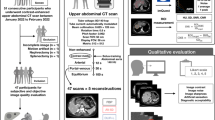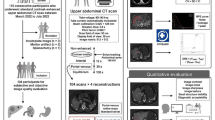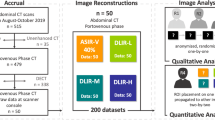Abstract
Objective
To investigate the effect of a deep learning-based denoising algorithm, PixelShine (PS), on the quality of 70 kVp pelvic arterial phase CT images.
Materials and methods
A retrospective analysis was performed on arterial phase pelvic CT images from 33 patients (body-mass index ≤ 20 kg/m2) obtained with a GE Revolution CT (70 kVp tube voltage; adaptive statistical iterative reconstruction-Veo-filtered back projection, 50% blending) and designated group A. Group B images were then obtained by applying PS to group A image datasets. Subjective image quality was evaluated by two radiologists with a 5-point scoring system; the scores of the groups were compared. Image signal was assessed using CT values of the urinary bladder. CT and standard deviation (SD) values of the gluteus maximus were measured, and SD values of the gluteus maximus were used to represent image noise. The signal-to-noise ratio (SNR) and contrast-to-noise ratio (CNR) of the bladder were calculated. Image noise, SNR, and CNR of two groups were compared using paired t-tests.
Results
The subjective visual image quality scores of groups A and B, respectively, were 3.11 ± 0.30 vs. 3.82 ± 0.57; image noise was 15.79 ± 2.05 Hounsfield units (HU) vs. 11.06 ± 2.22 HU; SNRs of bladder were 0.50 ± 0.23 vs. 0.79 ± 0.39; and CNRs of bladder were 3.72 ± 0.85 vs. 5.14 ± 1.27. Group B showed better subjective image quality, lower image noise, and improved SNR and CNR, compared to group A; these differences were statistically significant (P < 0.05). The noise of group B was approximately 30% lower than that of group A; the SNR and CNR values of group B were improved by approximately 58% and 38%, respectively.
Conclusion
Using 70 kVp +ASiR-V, PS can improve the image quality of pelvic arterial phase CT images, significantly reduce the image noise, and improve the SNR and CNR.
Similar content being viewed by others
Explore related subjects
Discover the latest articles, news and stories from top researchers in related subjects.Avoid common mistakes on your manuscript.
Introduction
CT radiation dose is greatly affected by body mass index (BMI) of patients, especially those with smaller BMI; the same CT scan conditions can cause excessive radiation exposure [1], thereby increasing health risks. Since radiation dose is proportional to the square of the tube voltage, reducing tube voltage can effectively reduce the radiation dose [2]. However, when the voltage is reduced, image noise will rise accordingly, thus affecting the quality of the image. The pelvis has many bone structures that reduce the tube voltage; this causes difficulty in X-ray penetration, such that the increased image noise is more noticeable.
With the rapid development of CT technology, various post-processing techniques have emerged to reduce image noise; in particular, iterative reconstruction (IR) technology has been widely used in clinical settings. The high-end revolution CT configuration of adaptive statistical IR-Veo (ASiR-V) can effectively reduce the noise caused by low tube voltage scanning [3]. PixelShine (PS), developed by AlgoMedica PS [4,5,6], can further reduce the noise of IR images and improve the image quality. The purpose of this study was to investigate the ability of PS to increase the quality of 70 kVp+ASiR-V reconstruction pelvic arterial phase CT images.
Materials and methods
Patient characteristics
Data for retrospective analysis were collected from 33 patients with gastrointestinal tumours who underwent whole abdominal, low-dose CTA scan between December 2015 and June 2016. The patients included 20 men and 13 women, with an average age of 64 ± 11 years old (range 36–83 years). All patients had BMI of < 22 kg/m2. Written informed consent was provided by all patients before examination.
Instruments and methods
Patients were placed on a low-residue diet 3 days prior to the examination; on the evening prior to examination, oral laxatives were used to clean the intestines. Patients were instructed to drink plenty of water before the examination to ensure a full bladder. Scanning was performed with Revolution CT (GE Healthcare, Chicago, IL, USA): spiral scanning, scan range from upper edge of the diaphragm to the lower edge of symphysis. High-resolution scanning mode was used, with tube voltage of 70 kVp, detector width of 80 mm, pitch of 0.992, automatic tube current technology, 50% ASiR-V, tube rotation speed of 0.5 s/r, Large scanning field, 512 × 512 matrix scan, thickness of 1.25 mm, and standard algorithm reconstruction. Using a high-pressure syringe (Ulrich Medical, Ulm, Germany) and an 18G intravenous catheter inserted into a cubital vein, nonionic contrast agent (iohexol, 350 mg I/ml, GE Healthcare) was injected at 300 mgI/kg body weight, with a rate of 4 ml/s; this was followed by a bolus of saline (40 ml) at the same injection rate. Scanning was performed with artificial intelligence to trigger scanning; the diaphragm level of the abdominal aorta was set as the monitoring level and the trigger threshold was set at 220 Hounsfield units (HU). At 10 s after injection of contrast agent, scan monitoring began automatically when the target vessel CT monitoring value reached the trigger threshold; the delay time was approximately 6 s.
Image analysis and data measurement
After the scan, CTA axis image (group A) data was transmitted to the AW4.6 workstation; then, the image was processed by the B2 model of PS (AlgoMedica, Inc, Sunnyvale, CA, USA) to obtain the processed images (group B). Pelvic section images were selected for analysis. The quality of the images was evaluated by two radiologists with 7 and 12 years of experience, respectively, in imaging diagnosis of abdominal diseases. Follow-up analysis was performed using an average of two observers. Standards for evaluation were the following [7]: 5 points—excellent image quality, bladder and prostate (or uterus) sharp boundaries, low noise, no artefacts, meeting the requirements of clinical diagnosis; 4 points—good image quality, bladder and prostate (or uterus) sharp boundaries, low noise, a small amount of artefacts, meeting the requirements of clinical diagnosis; 3 points—image quality medium, noise and artefacts, mostly meeting the requirements of clinical diagnosis; 2 points—poor image quality, noise and additional artefacts, cannot meet the requirements of clinical diagnosis; 1 point—poor image quality, serious noise and excessive artefacts, cannot be used for clinical diagnosis. A subjective score>3 points indicated an image that met clinical requirements.
Two observers measured the CT values of the bladder of both groups, as well as the gluteus maximus muscle of the same level. Regions of interest (ROIs) were located in the central intravesical bladder and homogeneous gluteal muscle without fat and blood vessels; an ROI area of 15–20 mm2 was measured to avoid artefacts, with each value the average of three measurements. The signal-to-noise ratio (SNR) and contrast-to-noise ratio (CNR) of the bladder were calculated according to the following formula:
where ROIo was the CT value of the bladder, ROId was the gluteus maximus CT value, and SDn was the standard deviation of the gluteus maximus CT value, which was used as the image noise. CT dose index was also recorded (CTDIvol).
Statistical analysis
SPSS 17 (SPSS, Inc., Chicago, IL, USA) statistical software was used to analyse the data. The Kappa test was used to evaluate image quality consistency of the two groups of images: a Kappa value of > 0.75 indicated good consistency, a Kappa value of 0.40–0.75 indicated fair consistency, and a Kappa value of < 0.40 indicated poor consistency. The Kruskal–Wallis test was used to compare differences in image quality score between the two groups. The intraclass correlation coefficient (ICC) was used to check the measured data consistency of the two observers: ICC value < 0.4 indicated poor consistency, ICC value > 0.75 indicated good consistency; analyses were performed on the mean data. Paired samples t tests were used to compare the noise of the two groups of images, as well as the SNR and CNR of the bladder. P < 0.05 was considered statistically significant.
Results
Two-observer score consistency and two-group image score comparison
The results of analyses of the two groups of images and the consistency of the two observers are shown in Table 1. The two observers were in good agreement, with Kappa values > 0.80. By two-observer average analysis, group A image quality score was 3.11 ± 0.30, while group B image quality score was 3.82 ± 0.57. Group B image quality score was statistically significantly higher than that of group A (Z = − 5.215, P < 0.001) (Fig. 1).
Two-observer consistency measurement and comparison of the two sets of data
Two observers measured the two sets of data; their consistency is shown in Table 2. The observers measured bladder CT values, gluteus maximus CT values, and image noise values from the two sets of images. The calculated bladder SNR and CNR were in good agreement, and the ICC values were greater than 0.75.
The results of noise and bladder SNR and CNR in the two groups of images are shown in Table 3. The bladder SNR and CNR in group B were significantly larger than in group A; image noise in group B was significantly lower than in group A (P < 0.05 for both).
CTDIvol of cases was 2.05 ± 0.12 mGy (mean ± SD value).
Discussion
CT equipment typically uses filtered back projection (FBP) for image analysis and reconstruction. FBP achieves faster image reconstruction, but exhibits a poor noise suppression effect; thus, when the radiation dose is low, image quality can be reduced [8]. IR technology is slower to reconstruct images than FBP, but can reduce image noise and radiation dose, while improving image quality. The ASiR reconstruction technique uses IR technology by first establishing the statistical noise model; then, the iterative method of noise suppression and correction is used to accelerate the speed of image reconstruction, reduce the noise of the reconstructed image, and improve the image quality [9]. Model-based iterative reconstruction (MBIR) is another type of IR technology, which differs from ASiR; in addition to the establishment of a statistical noise model, MBIR establishes a physical model and a model of the optical system. Further, it demonstrates a real reduction of X-rays from projection through the whole process of collection, concomitantly improving spatial resolution and reducing radiation dose [10]. However, due to the large amount of computation involved in the optical model, MBIR has a longer reconstruction time.
The high-end revolution CT adopts a more iterative reconstruction platform: ASiR-V, which reduces dosage and improves reconstruction speed. ASiR-V is a full model, real-time iterative platform, which combines the advantages of real-time reconstruction of ASiR and the advantages of the multiple model iterations of MBIR; additionally, it adopts a more advanced system noise model, scanned object model, and physical model [11]. Considering the advanced system noise model in ASiR-V technology, including photon noise and electronic noise in the data acquisition system, and the noise of the reconstruction of the spectrum, this technology is mainly used to reduce noise, improve low-density contrast, and reduce image artefacts [12].
Compared to other linear methods to reduce radiation doses, the radiation dose is greater when using lower tube voltage scans. Especially for pelvic CT scan, it is important to reduce the radiation dose to protect the patients’ reproductive cells and reproductive glands. However, reduction of the tube voltage will increase the image noise and affect the quality of the image. At the same time, because the pelvic cavity is surrounded by bony structures, reducing the tube voltage will increase the difficulty for X-ray penetration, and the image noise will be obviously increased. Early studies by our team confirmed that in patients with BMI < 22 kg/m2, undergoing 70 kVp low tube voltage for abdominal CTA scanning, combined with ASiR-V technology, led to improvements in display and significant reductions in radiation dose to abdominal vasculature [13]. In terms of CTA scans, there are few reports regarding whether organs can be observed.
A neural network is connected by many simple neurons, such that the output of one neuron serves as the input of another neuron. The principle of PS is based on the neural network model (Fig. 2). Each neuron accepts input from xi other neurons, using the nonlinear activation function\( f( \cdot )\), adding the summation value to control for bias, then calculating the weighted sum and output value of y. The formula is:
Deep neural network model (a) and a neuron (b). A neural network is formed by connecting together many of simple “neurons,” so that the output of a neuron can be the input of another. Although the details of PS is confidential, A indicates a neural network models used for PS. In this figure, each circle indicates a neuron, which is shown in B
PS is a noise-reduction algorithm based on deep learning, which uses deep learning techniques and ultra-large amounts of high-dose and low-dose data for training. Multiple iterations are required during training, but no iterative computations are needed after training. As a result, PS handles images quickly and can process more than eight images per second; it can be implemented on computers without GPUs. The techniques used by PS are quite different from traditional iterative reconstruction techniques, which process images that are reconstructed, rather than sinusoidal. Therefore, PS can be used to process iterative images. PS can greatly reduce image noise and provide different processing intensity levels, with control of processing intensity. PS provides B1–B5 modes. The B are slightly sharper kernel processing. The number indicates the strength of noise reduction and 1 is the mildest and 5 is the strongest. In this research, we chose the B2 mode. In addition, PS can be matched with a variety of iterative reconstruction techniques for iteratively reconstructing images to further reduce noise.
This research is based on the 70 kVp low voltage, combined with ASiR-V technology, and further improves image quality using PS technology. Our results show good consistency between the two observers in terms of subjective quality score and objective data measurement, indicating that PS has greater stability. An image of the pelvic arterial phase of PS, obtained by 70 kVp, showed lower image noise (approximately 30% lower than the image before PS treatment), and image quality was significantly improved. Concomitantly, SNR and CNR of bladder were approximately 58% and 38% higher than before treatment, suggesting that PS can enable observation of the viscera by CTA image. Previous studies [3,14] have shown that when ASiR-V is too high, soft tissue or abdominal lesions may cause distortion and unclear display be due to low noise levels. In this research, we chose the 50% ASiR-V.
The main limitation of this study is that the effect of PS on lesion display has not been explored and needs further study.
In conclusion, post-processing of ASiR-V using PS can improve the quality of 70 kVp pelvic arterial phase images, reduce image noise, and enhance image SNR and CNR. Thus, this post-processing approach may have a wide range of clinical applications in CT.
References
Schreiner MM, Platzgummer H, Unterhumer S, et al. A BMI-adjusted ultra-low-dose CT angiography protocol for the peripheral arteries-Image quality, diagnostic accuracy and radiation exposure. Eur J Radiol. 2017;93:149–56.
Benz MR, Szucs-Farkas Z, Froehlich JM, et al. Scan time adapted contrast agent injection protocols with low volume for low-tube voltage CT angiography: An in vitro study. Eur J Radiol. 2017;93:65–9.
Lim K, Kwon H, Cho J, et al. Initial phantom study comparing image quality in computed tomography using adaptive statistical iterative reconstruction and new adaptive statistical iterative reconstruction v. J Comput Assist Tomogr. 2015;39(3):443–8.
Hasegawa A. “Noise reduction processing by AI—PixelShine”, Innervision, vol. 32, pp 31–34 (in Japanese).
Cross NM, DeBerry J, Ortiz D, Kemp J, Morey J. “Diagnostic quality of machine learning algorithm for optimization of low-dose computed tomography data”, Society For Imaging Informatics in Medicine (SIIM; June 1–3. PA): Pittsburgh; 2017.
Nagaraj Y, van Den Oever LB, Guo J, Oudkerk M, van Ooijen PM. Perceived quality measurement of low-dose lung CT after retrospective neural network image enhancement. European Society of Thoracic Imaging, ESCR, May 24-26, Geneva, Switzerland; 2018.
Pinho DF, Kulkarni NM, Krishnaraj A, et al. Initial experience with single-source dual-energy CT abdominal angiography and comparison with single-energy CT angiography: image quality, enhancement, diagnosis and radiation dose. Eur Radiol. 2013;23(2):351–9.
André F, Fortner P, Vembar M, et al. Improved image quality with simultaneously reduced radiation exposure: Knowledge-based iterative model reconstruction algorithms for coronary CT angiography in a clinical setting. J Cardiovasc Comput Tomogr. 2017;11(3):213–20.
Katsura M, Sato J, Akahane M, et al. Effects of pure and hybrid iterative reconstruction algorithms on high-resolution computed tomography in the evaluation of interstitial lung disease. Eur J Radiol. 2017;93:243–51.
Higaki T, Tatsugami F, Fujioka C, et al. Visualization of simulated small vessels on computed tomography using a model-based iterative reconstruction technique. Data Brief. 2017;13:437–43.
Benz DC, Gräni C, Mikulicic F, et al. Adaptive statistical iterative reconstruction-V: impact on image quality in ultralow-dose coronary computed tomography angiography. J Comput Assist Tomogr. 2016;40(6):958–63.
Kim HG, Lee HJ, Lee SK, et al. Head CT: Image quality improvement with ASIR-V using a reduced radiation dose protocol for children. Eur Radiol. 2017;27(9):3609–17.
Yijun LIU, Ailian LIU, Xin FANG, et al. Feasibility of low radiation dose and iodine contrast medium in 70kVp abdominal CTA in low body mass index patients. Chin J Med Imaging Technol. 2017;33(3):473–7.
Kwon H, Cho J, Oh J, et al. The adaptive statistical iterative reconstruction-V technique for radiation dose reduction in abdominal CT: comparison with the adaptive statistical iterative reconstruction technique. Br J Radiol. 2015;88(1054):20150463.
Funding
This research did not receive any specific grant from funding agencies in the public, commercial, or not-for-profit sectors.
Author information
Authors and Affiliations
Corresponding author
Ethics declarations
Conflict of interest
All authors declare that they have no conflict of interest.
About this article
Cite this article
Tian, Sf., Liu, Al., Liu, Jh. et al. Potential value of the PixelShine deep learning algorithm for increasing quality of 70 kVp+ASiR-V reconstruction pelvic arterial phase CT images. Jpn J Radiol 37, 186–190 (2019). https://doi.org/10.1007/s11604-018-0798-0
Received:
Accepted:
Published:
Issue Date:
DOI: https://doi.org/10.1007/s11604-018-0798-0






